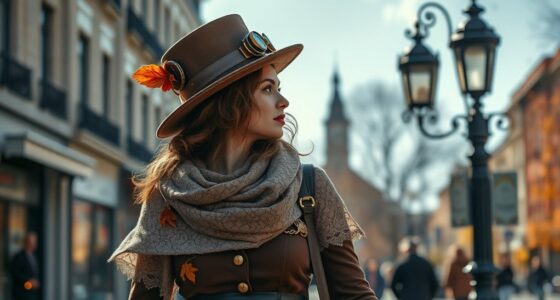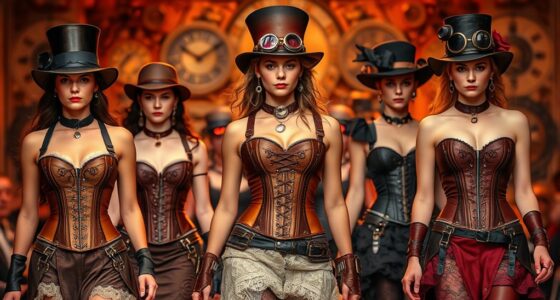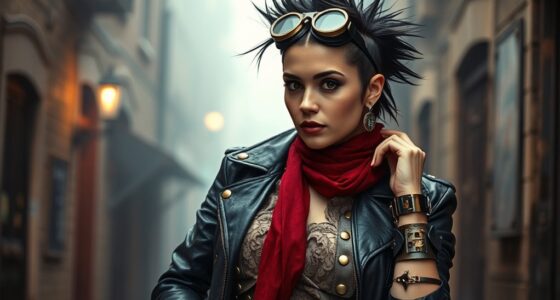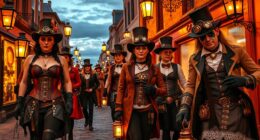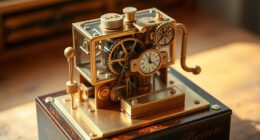Victorian influence on steampunk style is evident in its ornate fashion, intricate craftsmanship, and love for machinery. You’ll notice layered clothing, lace, high collars, and accessories like pocket watches and goggles that showcase Victorian elegance and detailed attention. Mechanical gears, cogs, and steam engines evoke the era’s fascination with progress. If you explore further, you’ll uncover how these historic elements blend to create a nostalgic yet innovative aesthetic that defines steampunk design.
Key Takeaways
- Victorian era’s rapid technological innovation and societal change provide the visual and cultural foundation for steampunk.
- Gears, cogs, and steam engines reflect Victorian fascination with engineering and industrial progress.
- Accessories like pocket watches, goggles, and top hats showcase Victorian craftsmanship and storytelling elements.
- Fashion features layered fabrics, lace, brocade, and high collars, blending Victorian elegance with mechanical rebellion.
- Victorian ideals of artisanship and detailed tailoring influence steampunk’s ornate, handcrafted aesthetic.

Have you ever wondered why steampunk fashion and design so heavily draw from Victorian aesthetics? It’s because the Victorian era, a time of rapid technological innovation and societal change, provides a rich visual and cultural foundation for the genre. When you look at steampunk, you notice how it blends the ornate elegance of 19th-century Britain with the gritty, mechanical feel of industrial machinery. This combination creates a distinctive style that feels both nostalgic and futuristic, capturing the imagination of enthusiasts who love history and innovation alike.
The Victorian period was marked by a fascination with progress, which is reflected in the way steampunk incorporates industrial machinery into its design. Think of gears, cogs, and steam engines—these elements aren’t just functional; they’re visual symbols of the era’s engineering marvels. When you craft steampunk outfits or interiors, you often include these mechanical details, making them look both vintage and inventive. It’s like wearing a piece of history that also hints at a future powered by steam and invention. These mechanical accents aren’t just decoration—they evoke the era’s obsession with progress and innovation, giving your style a sense of purpose and storytelling.
Fashion accessories play a pivotal role in emphasizing Victorian influence. If you’re dressing in steampunk style, you’re likely to wear items like pocket watches, goggles, top hats, and corsets—all staples of Victorian fashion. These accessories aren’t just decorative; they serve as a nod to the period’s craftsmanship and attention to detail. For example, a well-crafted pocket watch not only keeps time but also signals a love for the intricate and the artisanal. Goggles, another signature accessory, link back to Victorian explorers and inventors, emphasizing adventure and discovery. When you select your accessories, you’re choosing pieces that connect you to a history of innovation and elegance.
The Victorian influence also shows in the layered clothing, lace, brocade fabrics, and high collars that define the style. These details lend an air of sophistication and refinement, even as you incorporate steampunk’s rebellious, inventive spirit. You’re fundamentally blending the formality and grandeur of Victorian fashion with the raw, mechanical energy of industrial machinery. This fusion creates a look that’s both timeless and imaginative. Whether you’re attending a steampunk event or just experimenting with your wardrobe, understanding these Victorian elements helps you capture the essence of the style—an homage to a period that celebrated progress, craftsmanship, and a love of the extraordinary. Additionally, Victorian ideals of artisanship and craftsmanship are reflected in the detailed tailoring and ornate embellishments characteristic of the style.
Frequently Asked Questions
How Did Victorian Fashion Influence Modern Steampunk Costume Design?
Victorian fashion influences modern steampunk costume design through its rich, intricate details and layered styles. You embrace industrial innovation by incorporating gears, cogs, and metal accents, reflecting the era’s technological advancements. The fashion evolution from elegant dresses to tailored waistcoats inspires your creative outfits. By blending historical elegance with modern materials, you create unique steampunk looks that honor Victorian aesthetics while celebrating contemporary craftsmanship.
What Victorian Inventions Are Most Reflected in Steampunk Aesthetics?
You’ll notice gas lighting and mechanical clocks dominate steampunk aesthetics, transforming everyday environments into a dazzling, clockwork wonderland. These Victorian inventions inspire the intricate gears, luminous lamps, and vintage timepieces that define the style. Gas lighting’s warm glow creates an atmospheric ambiance, while mechanical clocks symbolize innovation and the passage of time. Their influence fuels the imaginative blend of past and future that makes steampunk so enthralling and visually stunning.
Are Victorian Societal Norms Visible in Steampunk Culture Today?
Yes, Victorian societal norms are visible in steampunk culture today. You’ll notice a focus on social hierarchy, with costumes and accessories often reflecting class distinctions. Gender roles also play a part, as many steampunk enthusiasts embrace traditional Victorian styles that emphasize distinct male and female aesthetics. This cultural homage highlights the era’s influence, allowing you to explore and reinterpret Victorian ideas within a modern, creative context.
How Did Victorian Literature Shape Steampunk Storytelling Themes?
You see Victorian literature shaping steampunk storytelling themes through its focus on the Industrial Revolution and social hierarchy. It inspires you to explore innovation, technology, and class struggles in your stories, creating a rich, layered world. The themes of progress and societal change from Victorian novels influence your narratives, emphasizing characters steering the complexities of a rapidly advancing, hierarchical society, which adds depth and authenticity to your steampunk adventures.
What Victorian-Era Architecture Is Most Commonly Incorporated Into Steampunk Design?
You’ll notice Victorian industrial and Gothic Revival architecture most commonly incorporated into steampunk design. The industrial elements, like exposed gears and brickwork, evoke the era’s manufacturing boom, while Gothic Revival details—pointed arches, intricate ironwork—add a dark, romantic touch. These styles blend seamlessly, creating a richly textured, vintage-futuristic aesthetic that captures the essence of Victorian innovation and mystique.
Conclusion
So, here you are, decked out in Victorian-inspired gear, embracing the steampunk aesthetic. Ironically, while you celebrate innovation and progress, you’re wearing a style rooted in a time of strict social hierarchies and limited technology. It’s a charming contradiction—using the past’s ornate elegance to showcase a future that never quite arrived as envisioned. But hey, isn’t it kind of perfect? After all, what’s more steampunk than blending old-world charm with modern rebellion?


